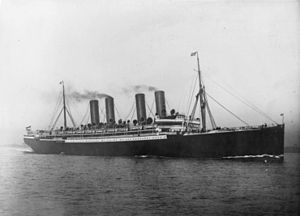SS Kaiser Wilhelm der Grosse

SS Kaiser Wilhelm der Grosse
|
|
| History | |
|---|---|
| Name: | Kaiser Wilhelm der Grosse |
| Namesake: | William I, German Emperor |
| Owner: | North German Lloyd |
| Port of registry: |
|
| Builder: | Stettiner Vulcan, Stettin |
| Laid down: | 1896 |
| Launched: | 4 May 1897 |
| Christened: | 4 May 1897 |
| Maiden voyage: | 19 September 1897 |
| Fate: | Scuttled in battle, 26 August 1914 |
| General characteristics | |
| Type: | Ocean liner |
| Tonnage: |
|
| Length: | 655 ft (200 m) |
| Beam: | 65 ft 9.6 in (20.056 m) |
| Draft: | 27 ft 11 in (8.51 m) |
| Installed power: | 33,000 ihp (25,000 kW) |
| Propulsion: |
|
| Speed: | 22.5 kn (41.7 km/h; 25.9 mph) |
| Capacity: | 1,506 passengers |
| Crew: | 488 |
| Armament: |
|
Kaiser Wilhelm der Grosse (Ger. orth. Kaiser Wilhelm der Große) was a German transatlantic ocean liner named after Wilhelm I, German Emperor, the first head of state of the German Empire. The liner was constructed in Stettin for the North German Lloyd (NDL), and entered service in 1897. It was the first liner to have four funnels and is considered to be the first-ever superliner. The first of four sister ships built between 1903 and 1907 by NDL (the others being SS Kronprinz Wilhelm, SS Kaiser Wilhelm II and SS Kronprinzessin Cecilie) she marked the beginning of a change in the way maritime supremacy was demonstrated in Europe at the beginning of the 20th century.
The ship began a new era in ocean travel and the novelty of having four funnels was quickly associated with size, strength, speed and above all luxury. Quickly established on the Atlantic, she gained the Blue Riband for Germany, a notable prize for the fastest trip from Europe to America which had been previously dominated by the British. In 1900, she was involved in a fire in the port of New York which resulted in several deaths. She was also the victim of a naval ram in the French port of Cherbourg in 1906. With the advent of her sister ships, she was modified to an all-third-class ship to take advantage of the lucrative immigrant market travelling to the United States.
Converted into an auxiliary cruiser during World War I, she was given orders to capture and destroy enemy ships within the first months of the war. Relatively successful, she destroyed several enemy ships before eventually being defeated in the Battle of Río de Oro the British cruiser HMS Highflyer and scuttled by her crew. Her wreck was rediscovered in 1952 and dismantled.
...
Wikipedia
